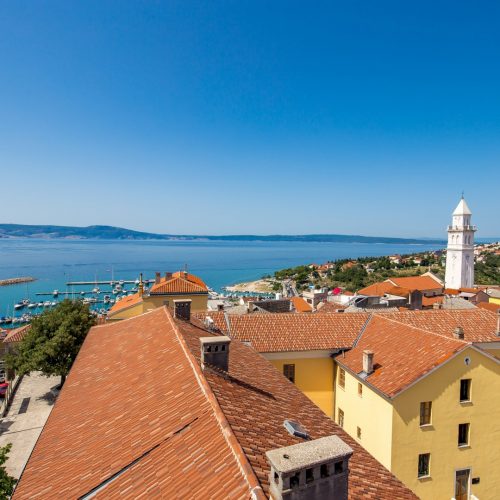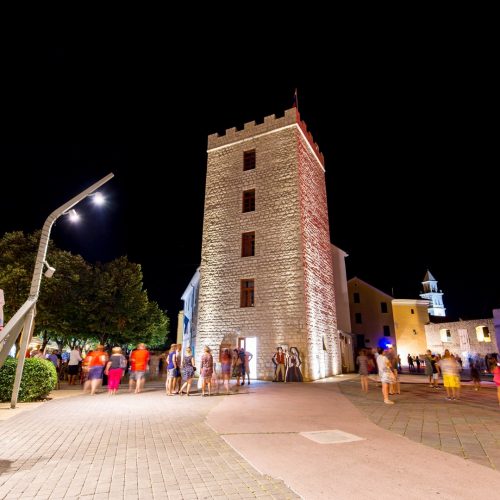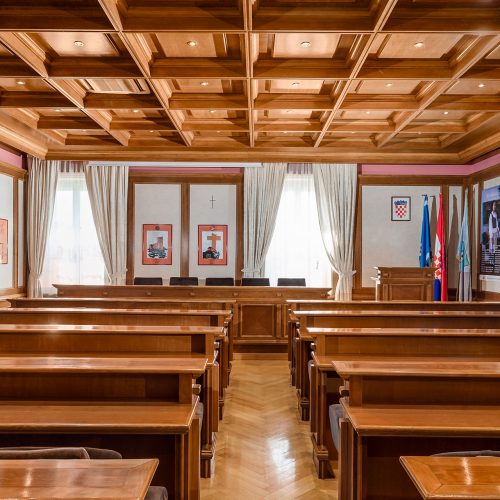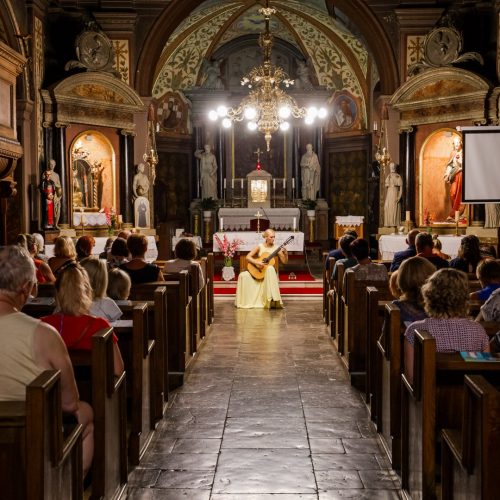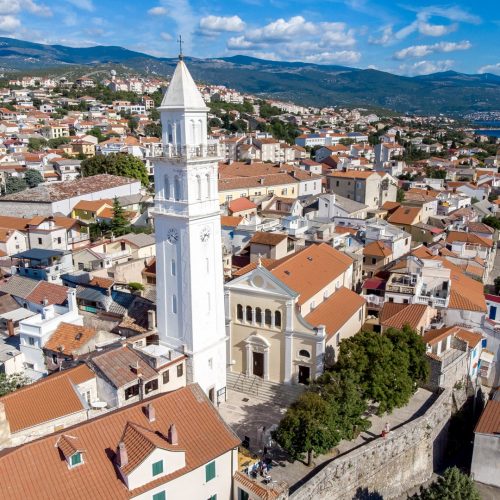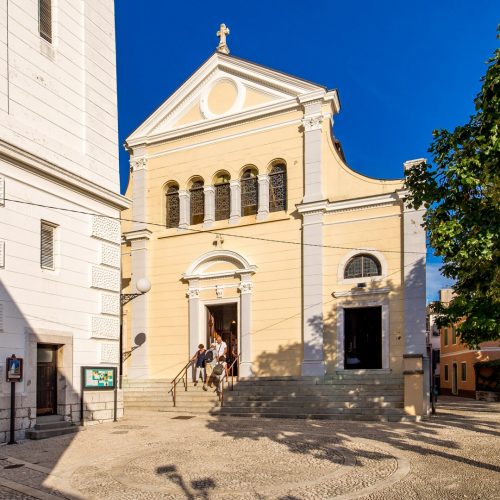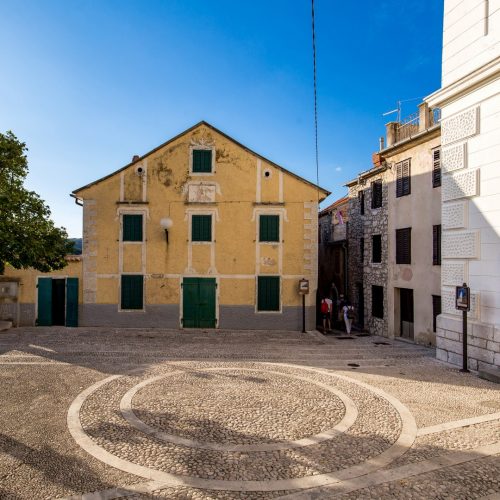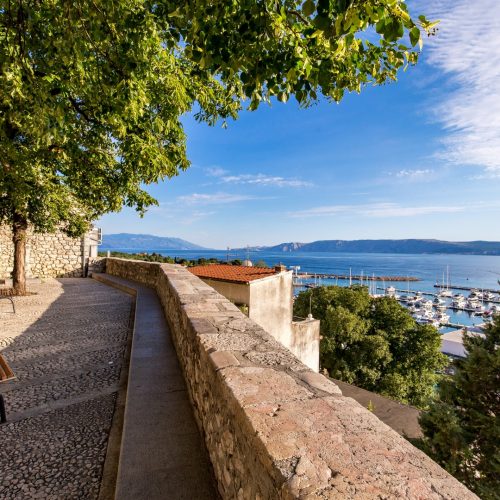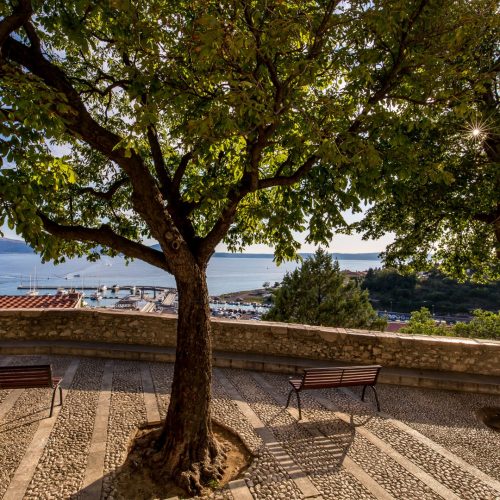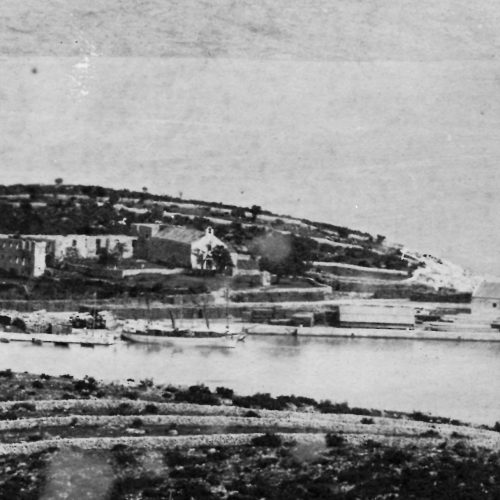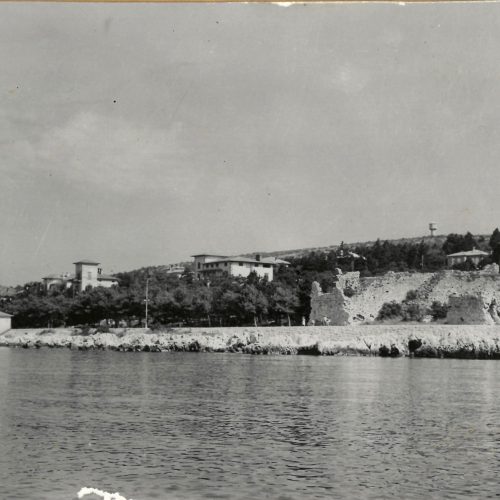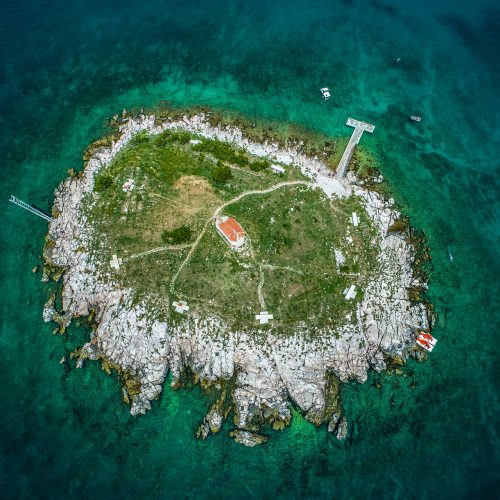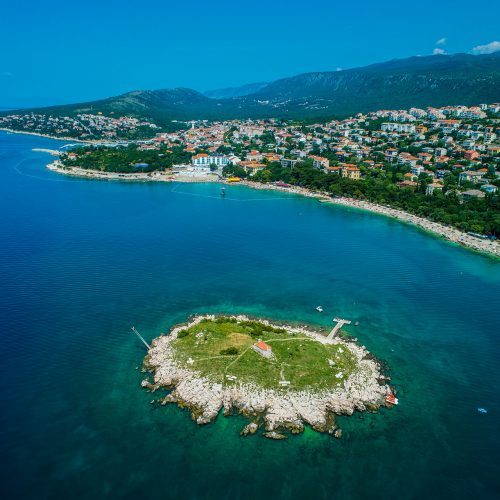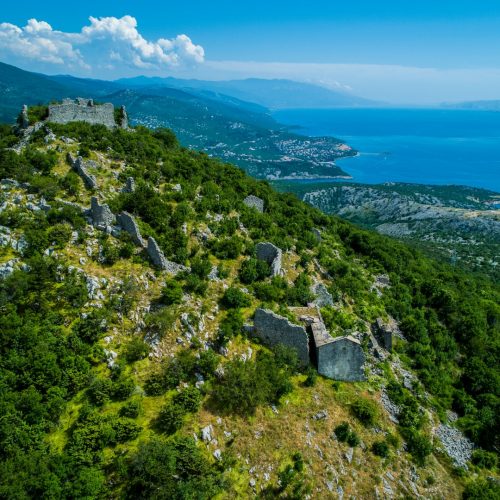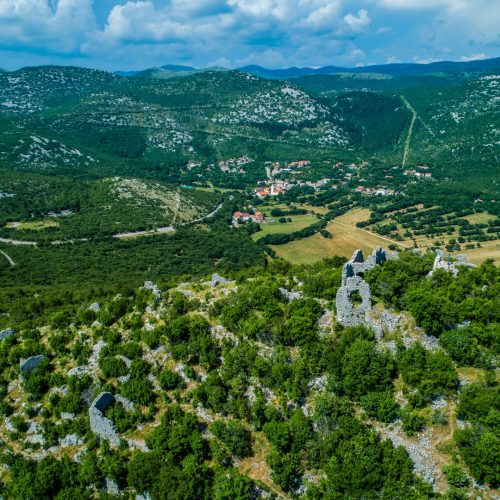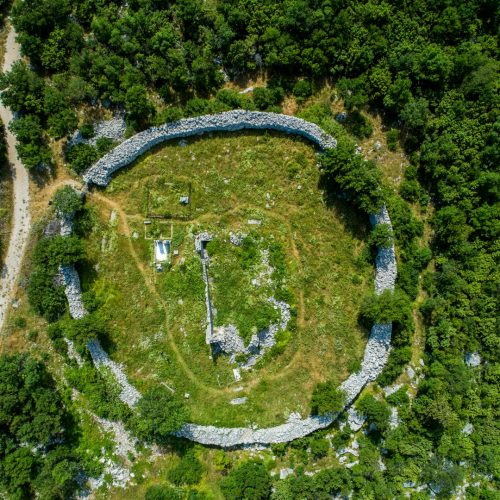Sights and monuments
Old Town
The old stone town is located on a hill, above the sea bay and the estuary of the river Ričina (Suha Ričina), and at the exit of the Vinodol valley to the sea. It was built by the dukes of Krk when they acquired Modruš and Vinodol with a royal charter in 1225.
Solid stone houses are compacted next to each other, and narrow streets lead to the parish church of St. Phillip and James, the former cathedral of the Diocese of Modruš or Krbava (1493-1969), with a rich interior and a high white recognisable bell tower.
In the square opposite the church is the diocesan building. Not far away is the church of St. Trinity (Chakavian Sv.Trojice) with a valuable sacral collection and the parish court (Prepožitura) – a former episcopal residence.
Frankopan Castle
The Frankopan castle is located in the old town and was built in the 13th century during the reign of the dukes of Krk – later called the Frankapans. The main entrance to the Frankopan Castle is today located on the Square of the Statute of Vinodol. Previously, it was the outer rampart of the fortified town of Novi, which was destroyed and burned in 1527 and 1530 by the Ottomans, and on August 29, 1615 by the Venetians, who attacked Novi with 6 galleys, 36 boats and 3000 soldiers. They demolished the main tower, robbed, and set fire to the city, took away three town cannons, and destroyed salt pans in Soline (in the area along Ričina below the Krase).
After the detention of Fran Krsto Frankapan in 1670 in Wiener Neustadt (where he was executed with Peter Zrinski in 1671), the castle was robbed, and in 1761 2/3 of the castle were demolished to save on maintenance costs. The south wing was kept, with the entrance to the castle and the east wing with two towers: the tower Turnac (Kvadrac) and the bastion tower Rundel (Tondac) that protected the town walls and Vela vrata, the entrance to the town of Novi.
Entrance to the town Vela vrata and the wall next to the Rundel tower were demolished in 1875, Rundel tower was demolished in 1892, and the castle underwent numerous alterations and renovations; the last in 1922-1923, which brought the castle to its present form. Only one biforium, Gothic window from the 15th century on the courtyard façade, and the accompanying tower Turnac, show that this is an old building.
On January 6, 1288, the Statute of Vinodol was written in the Frankopan Castle, the oldest legal monument in the Croatian language and Glagolitic script.
Today, the Frankopan Castle houses the National Museum and Gallery of Novi Vinodolski, the National Reading Room and Library of Novi Vinodolski and Town Administration with the Mayor’s Office.
Church of St. Philip and James and the bell tower
Church of St. Philip and James was built in the 14th century as a three-nave basilica. In the 18th century, the church was adapted to the baroque era and at the beginning of the 20th century the façade was renovated in the style of historicism. On the outer wall of the sanctuary, the year 1520 is engraved on two stones, with a combination of Arabic and Roman numerals, and then in Glagolitic script – most likely as a memorial to the restoration or rebuilding of the church, as the church itself is much older.
In front of the high altar there is the tomb of the Bishop of Modruš, Kristofor Dubrovčanin (Petančić), who escaped from Modruš with his chapter from the Ottomans and found refuge in Novi. He died there in 1499. The tombstone is made of marble and on it is a bishop’s figure with a Latin inscription. To the right of the altar is the tomb of Bishop Ivan Krstitelj Caballini, and to the left of Bishop Ivan Krstitelj Ježić. Above the door of the sacristy stands a relief tombstone of Canon Abbot Nikola Mrzljak, Vicar General of the Diocese of Modruš during the period of Bishop Ježić.
The altars were built in the 19th century in the neoclassical style. The church was decorated by master Peroš from Kastav.
Bell tower was in the front of the church, but it was demolished in 1909, and on the site of the demolished church of St. Fabian and Sebastian a new, 36-meter-high bell tower was built. The history of the little church is interesting. A stone slab has been preserved above the door of the demolished church (today in Zagreb at the Croatian History Museum). According to the folk tradition, it was built in 24 hours at the time of the plague, and St. Fabian and Sebastian are protectors against infectious diseases. Altar from 1656, decorated with carvings, is now located in the National Museum in the Novi Vinodolski Gallery.
Novi Vinodolski is recognisable by the view dominated by the high, white bell tower.
Diocese (Biškupija)
The bishop’s residence is located in the old town, on the square opposite the church of St. Philip and James. It was built in the middle of the 15th century. It has a stretched gable facing Precrikva Square, and a baroque façade divided by horizontal and vertical fields with shallow palmette ornaments. It was the residence of all the bishops of Modruš or Krbava. It was restored by Bishop Ivan Krstitelj Ježić (1779-1833).
Next to the Diocese is the Chapel of the Holy Cross, in which the priest used to place an iron cross (crucifix) on May 3rd, blessing the sea and the field. In the summer, the deputy prefect on the day of St. Peter would mark the beginning of summer by turning the crucifix to the sea and returned the cross to the church on the day of St. Michael.
Church of St. Trinity (Svete Trojice)
A single-nave Gothic church with a barrel-shaped vault over the sanctuary was built in the early 15th century. It is located in the Old Town, on the way from the Old Town to the port, not far from the Parish Palace. The altar of the church is the work of a local master, and its construction was instructed by the canon of Modruš, Antun Mažuranić, born in Novi (1687-1757). Since the middle of the eighties, after the renovation works, a collection of sacral art has been set up in it.
The collection is open for viewing in the summer months from 10:00. until 12:00 and from 20:00 to 23:00. For other months information are available in the Parish Office of St. Philip and St. James / Phone: +385 (51) 244 205 / Address: Braće Radića 39, 51250 Novi Vinodolski.
House of Mažuranić brothers
North of the Statute of Vinodol Square, in Antuna Mažuranića Street, is the house of Mažuranić brothers, a well-preserved house from the 19th century. It was initially residential, and since the middle of the 20th century it has been used for public purposes. The building has ambient value and special significance because of the family to which it belonged.
The Mažuranić family is an old family from Novi whose members have made an exceptional contribution to the development of Croatian politics, science, culture and art.
Three brothers Ivan, Antun and Matija were born in Novi. With their work and achievements, they marked the 19th century and left valuable traces in Croatian history.
Ivan, a writer, Ban and creator of the modern Croatian state, is especially important (he supplemented Gundulić’s Osman, he is the author of the epic work Smrt Smile Aga Čengića). He has been the President of Matica Ilirska and Croatia for many years, Parliament speaker, editor-in-chief of parliamentary conclusions and laws, court chancellor, Member of Parliament, President of the Croatian Parliament and the first Ban Commoner (not a nobleman). He introduced numerous reforms in education, judiciary and health. He spoke and wrote in a dozen languages. He studied mathematics and astronomy after his retirement.
Antun was a philologist and a writer, publisher of the Statute of Vinodol, one of the leaders of the Illyrian movement, a language expert.
Matija was an entrepreneur and writer of the first Croatian travel book Pogled u Bosnu; he built a larger building for his brothers and himself on the site of the old family house, and completed the construction in 1864 – with an inscription on the front of the house BRATJA MAŽURANIĆI (Mažuranić brothers).
Since 1921, the house has housed the Higher Public School, which since 1925 has been called the State Civic School. Since 1945, is has been a home of a student dormitory, which housed children from insurgent areas who were not able to attend school during the war, and later a home for children from the surrounding areas who attended classes in Novi. The institution was later called the Dječji dom braće Mažuranića (Mažuranić Brothers’ Children Home) until its deinstitutionalization in 2016.
Parish court – Prepožitura
Episcopal residence, a smaller mansion built in 1775 by the bishop Ivan Krstitelj Caballini. It is located in the city centre, above the port. Above the entrance to the courtyard is the coat of arms of the Caballini von Ehrenburg family (from Slavograd). The gable is oriented to the street Braće Radića, and the façade, with its arches and veranda above along its entire length, to the garden. Shallow palmettes, the work of a folk mason, frame the arched canopy of windows and doors.
In 1775, King (later Emperor) Joseph II of Habsburg spent the night there, on his return from Senj where he attended the opening of works on the Karlovac-Senj (Josephina) road.
Remains of the Pauline monastery
In 1462, on the peninsula near the port, duke Martin Frankapan Pobožni donated the Church of the Blessed Virgin Mary on Osap to the monks of the Order of St. Paul the Hermit, which he rebuilt. (Osap is the original name of the peninsula between the bays of Lišanj and Port, later called Fratarska Glavica or Glavica. The hill above Novi, today called Osap, was before called Veli Osap, Osep or Ospeč / Ospač). He also donated land to the Paulines for the construction of a monastery next to that church, in today’s cemetery in Novi.
In the documents on the history of the church and the Pauline monastery built next to it, there is a will of the parishioner Mihović from 1446, by which he leaves his property to the church. This is the proof that the church existed before that year.
The church was damaged in the earthquake of 1916 and collapsed in 1917. The remains of this church – the capitals of the supporting pillars, decorated with interesting carved depictions, are located in the lapidary of the National Museum and Gallery (on the ground floor of the Frankopan Castle).
On the peninsula Glavica, you can see only the remains of the monastery of the Order of St. Paul the Hermit (one wall), popularly called the White Friars because of the white robes they wore. They contributed to the education of children from this area until Joseph II; son and co-ruler of Maria Theresa, did not abolish the order in 1786 due to allegations that „monastic discipline has yielded”.
Novi’s cemetery was later formed on the site of the former monastery and church, and it is still in use today.
Lopar, ancient fortress
At the end of the promenade in the park of Ivan Mažuranić, formed at the beginning of 1904, are the remains of the ancient fortress Lopar. It was built in the 3rd or 4th century AD and served to protect traffic on the Roman road from Tarsatica to Seni.
Fragments of Roman vases made of clay and glass, as well as Roman coins, were found in the area between the fortress and the outer walls. Amphoras from the 1st to the 5th century BC were discovered in the sea area between the coast and the island of San Marino, and tombs from Roman times were discovered in the area of today’s Hotel Lišanj. Later, the wide stone walls of the fort served as a refuge for Slavic tribes that inhabited this area.
It was destroyed in 1598 during the Venetian attack on Novi by providur (supreme commander of the Venetian navy) Ivan (Zuana) Bemba.
The island San Marino
The island San Marino is only two hundred meters away from the coast. On it is the eponymous church built in the 17th-18th century on the foundations of an older building, and in 1818 it was restored. A 4th century marble slab (stela) with an inscription in honour of the Roman Empress Helena, erected by the governor of Dalmatia Flavius Julius Rufinus Sarmentius, was found in its foundations. The plaque is kept today in the Archaeological Museum in Zagreb, with Roman money from tomb excavations near Hotel Lišanj. From the time of Fran Krsto Frankapan (1663) to the Second World War, coastal tuna traps (tunere) were in function on the island. One tuna trap is today preserved on the island.
It is unusual that church customs have never been renewed on the island. Legend has it that a woman hid among the priests, and that the island was not actually called San Marino, but St. Marina.
Gradina Ledenice
Above the current settlement Ledenice, also called Ledenice Polje, on a sharp and rocky hill, at 376 m above sea level, the ruins of the old town of Ledenice – Gradina are located. It was an important strategic point in the battles that took place in the eastern part of Vinodol.
Ottoman invasions reached Ledenice in 1522 and 1539, and the Frankopans lost power over Ledenice in 1572, when Ledenice fell under the Senj captaincy.
The Venetians devastated Ledenice in 1600, and the Uskok dukes Marko and Juriša Margitić and the castellan from Ledenice Martin Posedarski defended the Ledenice castle.
In 1630, Ledenice became part of the Military Frontier. Until the liberation of Lika from the Ottomans in 1699, Ledenice were the walls that the West kept from the Ottoman invasion.
After the Treaty of Madrid in 1617, part of the Uskok epic and tragedy took place in Ledenice, which the Croatian writer August Šenoa described in the novel Čuvaj se senjske ruke. Legend has it that while collecting material for his novel about the Uskoks, and getting to know the old Gradina, the writer came up with the idea of the song Kugina kuća.
Today you can see the ruins of the former city, with the remains of a square tower and the church of St. Stephen. At the foot of the sinkhole is a unique round cemetery.

